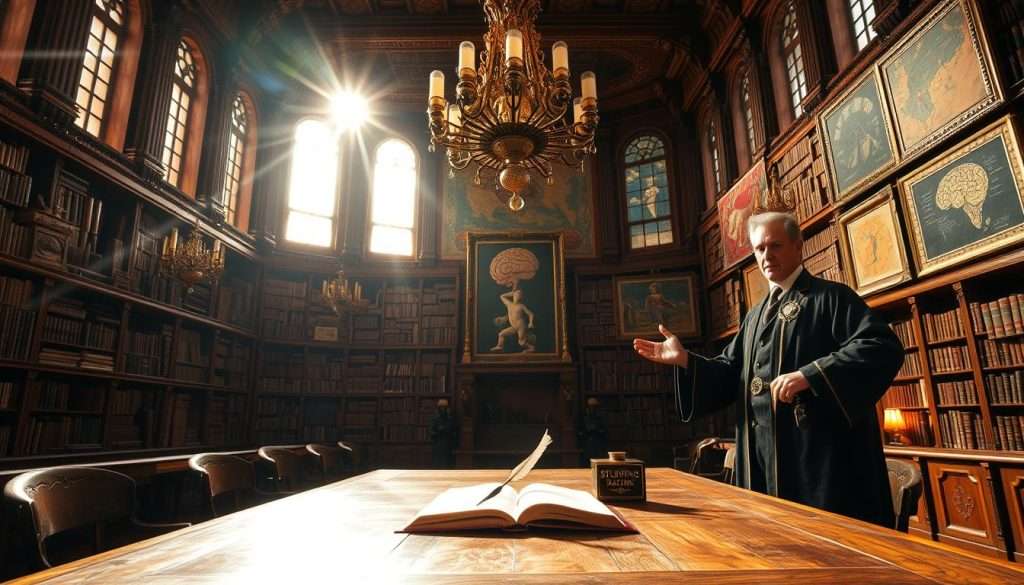Imagine remembering lots of information easily. This could be for school, a presentation, or just because you love learning. The Memory Palace, an ancient mnemonic technique, can make this possible.
This method uses a space you know well. You link the info you want to remember to spots in that space. It turns studying into something fun.
We’re here to teach you this technique. It can change your school life and more for the better!
Key Takeaways
- Discover the ancient technique used for memory improvement.
- Learn how to visualize and associate information with familiar locations.
- Transform studying into an enjoyable experience.
- Improve your ability to recall vast amounts of information.
- Achieve academic success with this powerful mnemonic technique.
The Ancient Art of Memory Enhancement
Ancient civilizations knew the power of the memory palace. This technique has lasted for centuries. It was used in ancient Greece and Rome by orators and philosophers.
Historical Origins of the Memory Palace
The memory palace technique goes back thousands of years. Before writing, our ancestors used it. Lynne Kelly’s 2019 book, The Memory Craft, shows how it helped them survive.
They remembered where to find food and dangers. This was key for their survival.
Why the Technique Has Endured for Centuries
The memory palace technique has lasted because it works well. It uses the brain’s spatial memory. This makes remembering easier by linking information to places.
It has been used for many years. It helps in school and work, showing its value.
What Is a Memory Palace and How Does It Work?
Ever wondered how some people remember so much? The Memory Palace technique is the key. It uses your brain’s spatial memory to help you remember.
The Science Behind Spatial Memory
The Memory Palace uses mental imagery to link info with places in your mind. Studies show that remembering places helps you remember other things too.
How Memory Palaces Work in Your Brain
Using a Memory Palace activates many brain functions. Two main areas are involved:
The Role of Hippocampus
The hippocampus is key for remembering places and navigating. It helps you recall the spots in your Memory Palace.
Visual-Spatial Processing
Visual-spatial processing is also crucial. It lets you create clear mental pictures and link them to what you want to remember. This boosts cognitive enhancement.
Learning about Memory Palaces helps you see their power. It shows how they can improve your memory and thinking skills.
Benefits of Using a Memory Palace
Discover the power of the Memory Palace technique. It’s a method that boosts memory retention and recall. It uses your brain’s spatial memory to help you remember better.
Academic Applications
Students can really benefit from the Memory Palace. It helps with remembering dates, formulas, and literature. For example, medical students can recall anatomy, and language learners can memorize vocabulary.
Professional Advantages
Professionals also gain a lot from the Memory Palace. It’s great for remembering meetings, speeches, and presentations. Salespeople can recall client names, and lawyers can remember case details.
Everyday Memory Improvement
The Memory Palace technique is also useful for everyday memory. It helps with remembering shopping lists, appointments, and tasks. Imagine being able to recall where you placed your keys or what you had for dinner last week!
Adding the Memory Palace technique to your daily routine can greatly improve your memory. It’s a valuable tool for anyone wanting to boost their memory skills.
Preparing to Build Your Memory Palace
The first step in using the memory palace technique is preparation. To build your memory palace well, pick a good location and gather your mental tools.
Choosing the Right Location
Choosing a location for your memory palace is key. You can pick a place you know or create a new one.
Familiar vs. Imaginary Spaces
Familiar places, like your childhood home, are good because you know them. Imaginary places offer endless options. Think about what suits you best.
Gathering Your Mental Tools
To move around your memory palace well, you need to improve your visualization skills.
Visualization Exercises
Start by practicing to see things in your mind. For example, picture yourself walking through a place you know and notice the small details. This will help you make clear mental pictures.
| Tool | Description | Benefit |
|---|---|---|
| Visualization | Creating vivid mental images | Enhances memory retention |
| Association | Linking new info to existing knowledge | Improves recall |
| Attention to detail | Focusing on specifics | Boosts memory precision |
By picking the right spot and getting your mental tools ready, you’re ready to succeed with the memory palace technique.
Step-by-Step Guide to Creating Your First Memory Palace
Let’s start building your first Memory Palace. It’s a great way to improve your memory. It’s easy to do and can help you remember lots of things.
Selecting a Familiar Location
First, pick a place you know well. It could be your house, a park, or anywhere you like. Choose somewhere you know well to make it easier to remember.
Mapping Your Mental Route
After picking your place, plan a path through it. Pick a route that’s easy to remember. For example, if it’s your house, start at the door, then the living room, and end in the kitchen.
Establishing Distinct Loci
Next, find special spots along your path, called loci. These are where you’ll store your memories. Make these spots unique and easy to remember.
Creating Memorable Stations
To make your loci stick in your mind, use vivid images or feelings. For example, if a spot is a bookshelf, imagine something strange happening there. The weirder the image, the better it will stay in your memory.
Determining the Optimal Number of Locations
How many loci you need can vary. Start with 5 to 10 for your first Memory Palace. You can always add more as you get better.
By following these steps and practicing, you’ll get better at remembering things. The secret to a good Memory Palace is to be consistent and vivid in your images.
- Choose a familiar location for your Memory Palace.
- Map out a consistent mental route.
- Establish distinct loci along your route.
- Practice regularly to improve your memory training.
With time and practice, using a Memory Palace will become easier. It will help you remember and recall information better.
The Art of Creating Memorable Associations
The secret to better memory improvement lies in the associations you make. Using mental imagery and creating vivid, meaningful connections helps a lot. This way, you can remember information more easily.
Using Vivid Imagery
First, vivid imagery is key for associations. Imagine pictures that are relevant and striking. For example, link historical dates to memorable events or images.

Incorporating Emotion and Absurdity
Adding emotion and absurdity makes associations stick. Linking info to emotional or funny images helps. Our brains remember unusual and emotional events better.
Making Connections Stick
To keep these connections strong, use a mnemonic technique that feels personal. Linking info to a meaningful memory makes it stick better.
The Bizarreness Effect
The bizarreness effect shows that weird associations are easier to remember. Using surprise or absurdity in your imagery boosts memory.
| Technique | Description | Effectiveness |
|---|---|---|
| Vivid Imagery | Using striking images to associate with information | High |
| Emotion and Absurdity | Incorporating emotional and absurd elements | Very High |
| Bizarreness Effect | Utilizing unusual associations for better recall | Very High |
Mastering memorable associations greatly improves your memory improvement skills. Use vivid imagery, emotion, absurdity, or the bizarreness effect. The goal is to make the information personal and meaningful.
Practicing Your Memory Palace Technique
Practicing your Memory Palace technique is key to unlocking its full power. To get the most out of this memory technique, regular practice is essential. Daily training, increasing complexity, and testing your memory can boost your recall abilities.
Consistency is crucial in memory training. Like any skill, the more you practice, the better you’ll get. Commit to a daily routine that includes using your Memory Palace.
Daily Training Exercises
Start with simple exercises like memorizing a list or a short poem. For example, try to recall a shopping list by visualizing each item in your Memory Palace.
| Exercise | Description | Frequency |
|---|---|---|
| Memorize a list | Visualize items on a list in specific locations | Daily |
| Recall a poem | Use your Memory Palace to remember a short poem | 3 times a week |
| Memorize numbers | Practice recalling phone numbers or dates | 2 times a week |
Gradually Increasing Complexity
As you get more comfortable, increase the complexity of what you’re trying to remember. This could be longer lists, more complex information, or abstract concepts.
Testing and Reinforcing Your Memory
Regularly test your memory by recalling information without notes or references. This strengthens your memory and shows where to focus your practice.
By following these tips and consistently practicing, you can greatly improve your cognitive enhancement and memory.
Advanced Memory Palace Techniques
Once you get the hang of the Memory Palace technique, you’re ready for more. These advanced methods help you build complex memory structures. They let you remember more by linking different pieces of information together.
Creating Multiple Palaces
Building multiple Memory Palaces is a great way to improve your memory. You can create different mental spaces for different types of information. For example, one palace for history, another for words, and a third for math.

Nesting Information Within Locations
Nesting information means adding layers to your Memory Palace. Instead of just linking one piece of info to a spot, you can make sub-spaces. This is super helpful for remembering complex stuff with lots of parts.
Temporal Memory Palaces
Temporal Memory Palaces are for organizing info in order. They’re great for remembering things that happen in sequence, like history or steps in a process. By telling a story as you move through your palace, you can remember things in the right order.
| Technique | Description | Benefit |
|---|---|---|
| Multiple Palaces | Creating different mental spaces for different categories of information | Enhances organization and recall of diverse information |
| Nesting Information | Layering details within specific locations | Improves memory of complex, multi-component information |
| Temporal Memory Palaces | Organizing information in chronological order | Facilitates recall of sequences and timelines |
Common Challenges and How to Overcome Them
The Memory Palace technique can change the game, but it comes with its own set of challenges. Knowing how to tackle these is key. As you keep using this memory technique, you might face issues that affect its success.
Cluttered Locations
One big challenge is when your Memory Palace locations get too full of information. To solve this, try to organize your mental space. You can group information into clear categories or use different palaces for different types of info.
Dealing with Similar Information
Another hurdle is dealing with similar info that’s hard to tell apart. To overcome this, use vivid imagery and associations. This makes each piece of info unique and easy to remember.
Refreshing Fading Memories
Memories can fade over time, making recall harder. To keep your memories sharp, regularly visit your Memory Palaces. Practice recalling the info stored there. This boosts your cognitive enhancement and keeps your memories fresh.
By understanding these common challenges and finding ways to overcome them, you can keep improving your memory. This way, you’ll get the most out of the Memory Palace technique.
Real-Life Applications of the Memory Palace
The Memory Palace technique is more than just a theory. It has been used in many practical ways. People from different fields have used it to remember speeches, learn new languages, and master technical info.
Memorizing Speeches and Presentations
Many use the Memory Palace to memorize speeches and presentations. They link important points to places they know well. This makes it easy to recall their speeches confidently.
Public speakers, actors, and professionals use it to give perfect presentations.
Learning New Languages
The Memory Palace is great for learning new languages. It helps by linking new words to places. This way, learners can grow their vocabulary fast and speak fluently sooner.
Mastering Technical Information
Professionals in many fields use the Memory Palace for technical knowledge. Medical students, for example, memorize complex terms and procedures. They create mental maps of key concepts to recall info quickly.
Case Studies of Memory Champions
Memory champions have achieved amazing feats with the Memory Palace. Joshua Foer, from Moonwalking with Einstein, is a great example. He trained his brain to make vivid memories and associations. This allowed him to remember lots of information easily.
These stories show how the Memory Palace works in real life. It uses spatial memory to improve memory and thinking skills. People can do amazing things with it.
Conclusion: Unlocking Your Memory Potential
Mastering the Memory Palace technique can greatly boost your memory. We showed you how to make your own Memory Palace. This includes picking a familiar spot and doing daily exercises.
As you keep practicing, you’ll see your memory get better. This is true for school, work, or personal stuff. The Memory Palace is a great tool to help you reach your goals and improve your memory.
Now that you know how to use the Memory Palace, keep practicing. Try new ways to use it every day. With regular effort, you’ll be surprised at how much your memory can grow.

